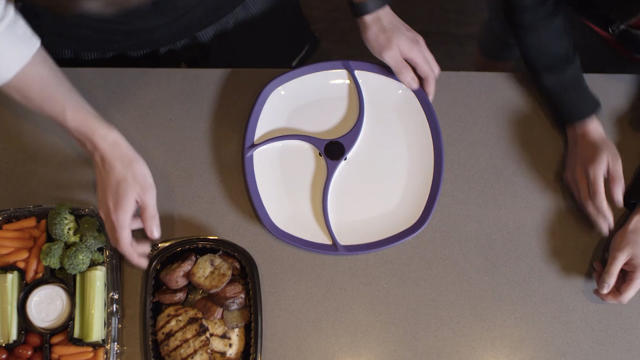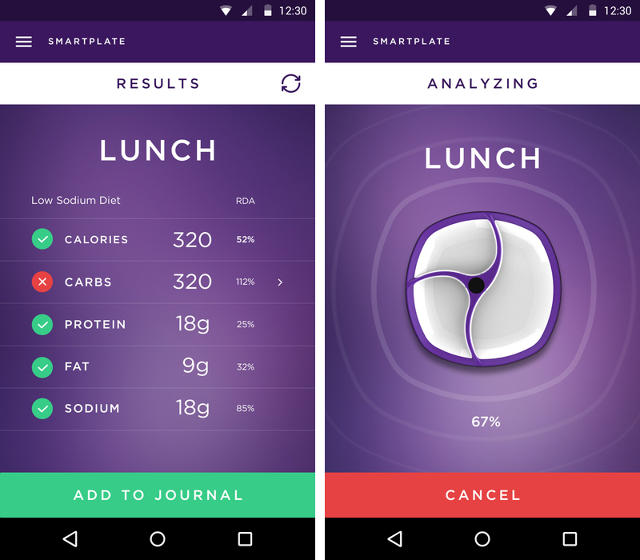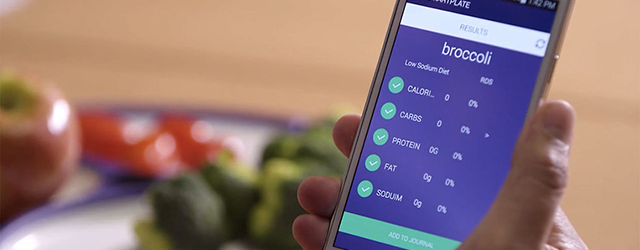This Smart Plate Tells You How Many Calories You're Eating—And Whether You're Eating Too Fast
The ultimate in portion control: a plate that yells at you.
Put your dinner on a new Wi-Fi connected SmartPlate, and it will tell you not only what you’re eating, how many calories are involved, which nutrients, and even whether you’re chewing too fast. All the data feeds into an app that tracks your nutrition over time.
The gadget’s creator was inspired after his father had a triple bypass surgery. “That was one of the scariest and toughest times for my family,” says Anthony Ortiz, CEO of Fitly, the SmartPlate’s maker. “What really angered me later on, as I started becoming more active and more into nutrition and health, was knowing that his condition was completely preventable. It’s a matter of education, culture, all these things play into the way we eat the way we do.”

Calorie-tracking apps—or an actual food diary on paper—are typically inaccurate because we guess (usually incorrectly) the portion size. Even newer scanning devices that are attempting to measure calories on a plate don’t do well at this. “If you talk to an expert they’ll say losing weight can just be the difference of 200 calories a day. If you talk about an apple that’s four ounces or an apple that’s seven ounces, those differences can add up,” Ortiz says.
The plate uses three digital cameras, the same type as in most smartphones, to scan each part of a meal. “It’s basically an object recognition algorithm that has been trained for food,” he says. The algorithms can identify a food with up to 99% accuracy, he says, and load sensors under each partition on the plate measure the exact weight of each portion.
If a meal has multiple components, like a salad or a rice pilaf, the plate will automatically calculate the percentage of each food. The only key is that the food has to be visible; if you’re eating a burrito, you’ll have to slice it open so the camera can look inside.
As the app tracks what you’re eating, it makes simple suggestions, like switching from white rice to brown rice. “We start with things that are very easy,” Ortiz says. Because Fitly’s main business is delivering kits of fresh ingredients for making meals, the app also makes suggestions of meals to order.

“We start to nudge people to spend more time in the kitchen, find that balance between convenience and health,” he says. “We know people are busy. Personally, as a professional, I don’t have more than five minutes to make breakfast. So if you ask me to crack an egg, it’s not going to happen.”
The plate can be customized for specific goals, like training for a marathon, losing weight, or managing a disease like diabetes. If a diabetic or runner has too many carbs, the plate will actually tell them how much of the food to take off the plate. It will even tell someone if they’re chewing too fast.
“Speed is important, because any expert will tell you it takes about 20 minutes for the brain to signal to the stomach that you’re full,” Ortiz says. “If you’re eating under 20 mins all the time, you’re going to be eating more. So the plate can help you manage that.”
If someone wants to bring food to work for lunch, they can measure it on the plate, then flip it into a portable, microwaveable lid that acts as a lunchbox. In theory, someone could use it for every meal.
Ultimately, it could also be useful for research on nutrition and health—right now, researchers have to rely on self-reporting from participants, while the plate could instantly report, down to the gram, what someone is actually having for dinner.
The SmartPlate will retail for $199, and can be preordered for $99 during the company’s crowdfunding campaign.





